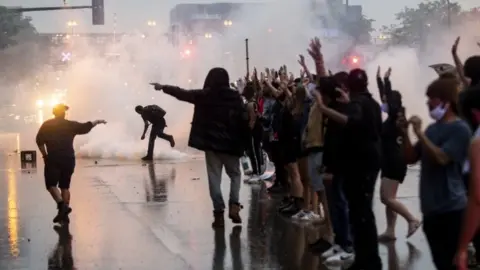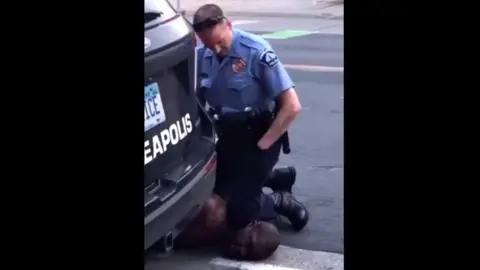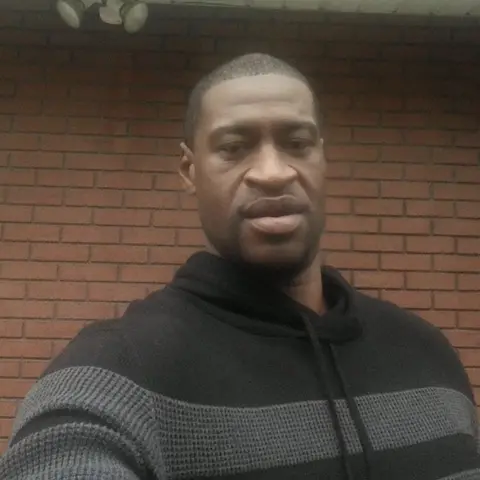George Floyd: Minnesota clashes over death in police custody
 Getty Images
Getty ImagesThere have been clashes between police and protesters in Minneapolis after the death on Monday of an unarmed black man in police custody in the US city.
Police fired tear gas and protesters threw rocks and sprayed graffiti on police cars.
Video of the death shows George Floyd, 46, groaning "I can't breathe" as a white policeman kneels on his neck.
Four police officers have been fired, with the mayor saying that being black "should not be a death sentence".
Mayor Jacob Frey also called on prosecutors to file criminal charges against the policeman who was filmed holding Mr Floyd.
The incident echoes the case of Eric Garner, who was placed in a police chokehold in New York in 2014. His death became a rallying call against police brutality and was a driving force in the Black Lives Matter movement.
What happened at the protests?
They began in the afternoon on Tuesday, when hundreds of people came to the intersection where the incident had taken place on Monday evening.
Organisers tried to keep the protest peaceful and maintain coronavirus social distancing, with demonstrators chanting "I can't breathe," and "It could've been me".
Protester Anita Murray told the Washington Post: "It's scary to come down here in the middle of the pandemic, but how could I stay away?"
A crowd of hundreds later marched to the 3rd Precinct, where the officers involved in the death are thought to have worked.
Squad cars were sprayed with graffiti and protesters threw stones at the police building. Police fired tear gas, flash grenades and foam projectiles.
 Getty Images
Getty ImagesOne protester told CBS: "It's real ugly. The police have to understand that this is the climate they have created."
Another said: "I got on my knees and I put up a peace sign and they tear-gassed me."
Police said one person had suffered non-life-threatening injuries after being shot away from the protest area but gave no further details.
What happened to George Floyd?
Officers responding to reports of the use of counterfeit money had approached Mr Floyd in his vehicle.
According to police he was told to step away from the vehicle and physically resisted officers.
 Darnella Frazier
Darnella FrazierA police statement said: "Officers were able to get the suspect into handcuffs and noted he appeared to be suffering medical distress."
The video taken at the scene does not show how the confrontation started.
It shows a white officer using his knee to pin Mr Floyd to the ground by the neck.
 Twitter/Ruth Richardson
Twitter/Ruth Richardson
Mr Floyd groans "please, I can't breathe" and "don't kill me" as bystanders urge officers to let him go.
He ceases to move and an ambulance arrives to take him to hospital where he later died.
What was the official response?
Mayor Frey said it was the "right call" to fire the officers.
He said: "Being black in America should not be a death sentence. For five minutes we watched as a white police officer pressed his knee into the neck of a black man. For five minutes. When you hear someone calling for help, you are supposed to help."
The FBI is investigating the incident and will present its findings to the Minnesota state's attorney for possible federal charges.
Minnesota Senator Amy Klobuchar urged a thorough outside investigation, saying: "Justice must be served for this man and his family, justice must be served for our community, justice must be served for our country."
There have been calls from some for the officers to be charged with murder.
The Minnesota police handbook states that officers trained on how to compress the neck without applying direct pressure to the airway can use a knee under its use-of-force policy. This is regarded as a non-deadly-force option.
What's the backstory here?
By Jessica Lussenhop in Minneapolis
The most surprising thing about the response to the in-custody death of George Floyd was the swiftness with which the four police officers involved were sacked. This is almost always the first demand made by protesters - a demand that is often never met.
While Minneapolis is a very liberal city, it is also very segregated and the region has seen several controversial police killings.
In 2017, Justine Damond was killed after she called to report a possible sexual assault in her alley. The officer was tried for murder and sentenced to 12.5 years in prison. During a 2016 traffic stop, Philando Castile was shot and killed by a police officer who was tried and acquitted of manslaughter. Jamar Clark was killed by Minneapolis officers in 2015, and charges were never brought.
All three incidents sparked large protest movements.
It seems plausible that city officials hoped their decisive action would prevent mass protests in the middle of the pandemic, but thousands took to the streets.
Demonstrators later smashed a police precinct door, and police used tear gas and non-lethal rounds, making it all but certain that these demonstrations will continue.
Why is the case so sensitive?
Allegations of police brutality have been constantly highlighted since the start of the Black Lives Matter movement. It began after the acquittal of neighbourhood watchman George Zimmerman in the shooting death of African-American Trayvon Martin in February 2012.
The deaths of Michael Brown in Ferguson and Eric Garner in New York in 2014 sparked huge protests.
"I can't breathe" became a national rallying cry as Garner, an unarmed black man, uttered the phrase 11 times after being detained by police in a chokehold on suspicion of illegally selling loose cigarettes.
The New York City police officer involved in Garner's arrest was fired five years later, but no officer was charged.
Recent allegations of police wrongdoing include the shooting of a black woman in her home in Louisville by three white Kentucky policemen and the shooting of a man by an officer in Maryland.
Police in Georgia are also accused of trying to cover up the killing of black jogger, Ahmaud Arbery, allegedly by the son of a retired law official.
Paige Fernandez of the American Civil Liberties Union, said of the latest case in Minnesota: "This tragic video shows how little meaningful change has emerged to prevent police from taking the lives of black people."